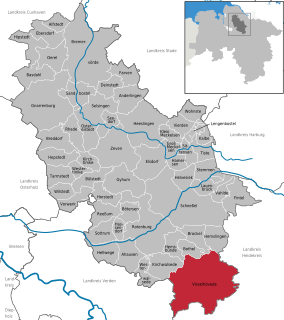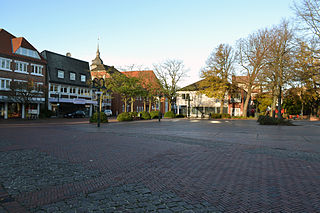Stade is a district (Landkreis) in Lower Saxony, Germany. It has its seat in Stade and is part of the Hamburg Metropolitan Region.

District Harburg is a district (Landkreis) in Hamburg and Lower Saxony, Germany. It takes its name from the town of Harburg upon Elbe, which used to be the capital of the district but is now part of Hamburg. It is bounded by the districts of Lüneburg, Heidekreis, Rotenburg (Wümme) and Stade, by the City of Hamburg and the State of Schleswig-Holstein.
Osterholz is a district (Landkreis) in Lower Saxony, Germany. It is bounded by the districts of Wesermarsch, Cuxhaven, Rotenburg and Verden, and by the city of Bremen.
Verden is a Kreis (district) in the centre of Lower Saxony, Germany. Adjoining it are the districts of Osterholz, Rotenburg, Heidekreis, Nienburg, and Diepholz, as well as the city of Bremen.

Rotenburg an der Wümme is a town in Lower Saxony, Germany. It is the capital of the district of Rotenburg.
Nienburg is a district (Landkreis) in Lower Saxony, Germany. It is bounded by the districts of Diepholz, Verden, Heidekreis, Hanover and Schaumburg, and by the state of North Rhine-Westphalia.

The Prince-Archbishopric of Bremen — not to be confused with the modern Archdiocese of Hamburg, founded in 1994 — was an ecclesiastical principality (787–1566/1648) of the Holy Roman Empire and the Catholic Church that after its definitive secularization in 1648 became the hereditary Duchy of Bremen. The prince-archbishopric, which was under the secular rule of the archbishop, consisted of about a third of the diocesan territory. The city of Bremen was de facto and de jure not part of the prince-archbishopric. Most of the prince-archbishopric lay rather in the area to the north of the city of Bremen, between the Weser and Elbe rivers. Even more confusingly, parts of the prince-archbishopric belonged in religious respect to the neighbouring Diocese of Verden, making up 10% of its diocesan territory.

Visselhövede is a town in the district of Rotenburg in Lower Saxony, Germany. Nearby towns include the district capital Rotenburg, Walsrode and Verden. Larger cities within a 100 km radius are Bremen, Hanover and Hamburg.

Bremen-Verden, formally the Duchies of Bremen and Verden, were two territories and immediate fiefs of the Holy Roman Empire, which emerged and gained imperial immediacy in 1180. By their original constitution they were prince-bishoprics of the Archdiocese of Bremen and Bishopric of Verden.

Bremervörde is a town in the north of the district (Landkreis) of Rotenburg, in Lower Saxony, Germany. It is situated on the Oste river near the centre of the "triangle" formed by the rivers Weser and Elbe, roughly equidistant from the cities of Hamburg, Bremen and Cuxhaven.

Scheeßel is a municipality in the district of Rotenburg, in Lower Saxony, Germany. It is situated on the river Wümme, approx. 10 km northeast of Rotenburg, 45 km east of Bremen, and 70 km southwest of Hamburg.

Sottrum is a municipality in the district of Rotenburg, in Lower Saxony, Germany. It is situated approximately 11 km west of Rotenburg, and 30 km east of Bremen.

Ahausen is a village in the district of Rotenburg, in Lower Saxony, Germany. Ahausen is administratively part of the collective community of Sottrum.
The Stade Region emerged in 1823 by an administrative reorganisation of the dominions of the Kingdom of Hanover, a sovereign state, whose then territory is almost completely part of today's German federal state of Lower Saxony. Until 1837 the Kingdom of Hanover was ruled in personal union by the Kings of the United Kingdom of Great Britain and Ireland.
The Stade Geest is a natural region of low, sandy heath (geest) in the North German Plain.

The region between the Elbe and Weser rivers forms the Elbe–Weser triangle, also rendered Elbe-Weser Triangle, in northern Germany. It is also colloquially referred to as the Nasses Dreieck or "wet triangle".

The Wümme Depression is a bog, geest and forest landscape within the Elbe–Weser triangle in the German state of Lower Saxony. It belongs mainly to the district of Rotenburg and is part of the Stade Geest. To the south it borders on the Achim-Verden Geest. It has no sharply defined boundary with the Lüneburg Heath; as a result many places are seen as belonging to both regions. Typical of the gently undulating terrain are the many small rivers, streams and lakes. These include the rivers Wümme, Wieste, Fintau, Rodau, Wiedau and Vissel, as well as the twin lakes known in German as the Bullenseen. In this ancient landscape Low German is commonly spoken.

The Prince-Bishopric of Verden was an ecclesiastical principality of the Holy Roman Empire that was located in what is today the state of Lower Saxony in Germany. Verden had been a diocese of the Catholic Church since the middle of the 8th century. The state was disestablished in 1648. The territory was managed by secular lords on behalf of the Bishop of Verden. As a Prince-Bishopric of the Empire, the territory of the state was not identical with that of the bishopric, but was located within its boundaries and made up about a quarter of the diocesan area. By the terms of the Peace of Westphalia, the Prince-Bishopric was disestablished and a new entity was established, the Duchies of Bremen and Verden.
The Zeven Geest, which is part of the Stade Geest, is an area of sandy terrain in the northeast of the German state of Lower Saxony. It is named after the town of Zeven.















